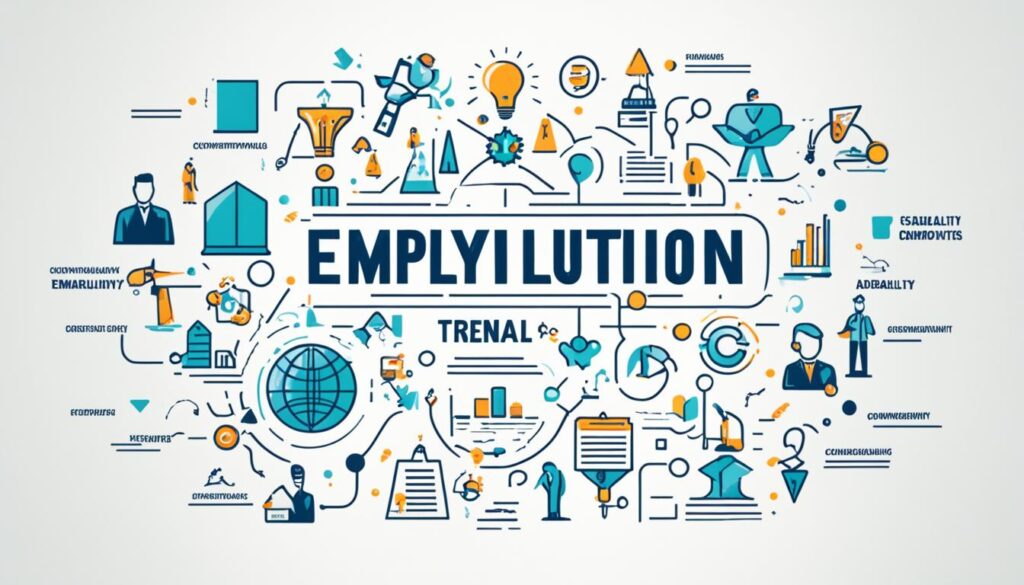The U.S. Bureau of Labor Statistics showed that the American job market might be slowing down. Job openings are a bit down, and less jobs were added to payrolls. But, the number of people being laid off stayed the same.
It’s good news though, wages are still rising for people who work. Most people are still finding jobs easily, keeping the unemployment rate below 4%.
But, in April, fewer jobs were added than any other month in 2024. The biggest jumps in jobs were in healthcare, social work, transportation, and stores.
Even though the economy might get a bit slower, prices keep rising. This is why the Federal Reserve keeps a close eye on how much people are getting paid.
The Federal Reserve thinks it might have to lower interest rates. This could happen if the job market gets worse. Investors are very interested in this news.
Key Takeaways:
- Recent data suggests a possible labor market slowdown in the United States.
- Job openings have declined, but job layoff activity remains stable.
- The unemployment rate has risen slightly but remains below 4%.
- Non-farm payrolls have been growing, but April saw the slowest month for job creation in 2024.
- Inflation has remained high, and the Fed is monitoring wage growth for potential rate cuts.
The Importance of Employability in the Labor Market
Employability is key in the job market. It’s about being able to get and keep a job. This means having the right skills to meet job needs.
Today’s job world demands quick skill upgrades. Keeping up and learning new things is essential. Employability isn’t just about job skills; it also includes how well you communicate and solve problems.
“Employability is not just about having a job, but about having the ability to continuously participate and thrive in the labor market.”
Without good employability, there can be different kinds of joblessness. This includes being between jobs or not fitting the skills employers need. This can lead to long times without work and hurt a country’s economy.
Working on your employability helps job seekers and those already employed. It makes you more attractive to employers and opens new career doors. Companies also do better with skilled workers, which helps the economy.
Benefits of Enhancing Employability:
- Improved job prospects and career opportunities
- Higher earning potential
- Increased job security
- Ability to adapt to changing market demands
- Greater job satisfaction and fulfillment
Let’s take a look at the link between employability, skills, and economic growth through a table:
| Employability | Skills | Economic Growth |
|---|---|---|
| High | Diverse and adaptable | Strong and sustained |
| Low | Limited or outdated | Stagnant or slow |
The table shows that those with great skills help economic growth. Those lacking skills might slow down the economy. This affects their job search and job stability.
Investing in employability makes a big difference for all. It’s about always learning and staying adaptable. This way, you can grab more chances in the changing job market.
The Impact of Employability on the Economy
Employability is key to making our economy grow. People with the right skills help boost the economy. This makes the economy better for everyone, with more money per person and a higher quality of life.
Nations become stronger by teaching their people new skills. A skilled worker can do more in their job, making their company better. This leads to new ideas, better work, and more success in different fields.
People with good job skills find work easier, which lowers jobless rates. With fewer people out of work, more feel confident about spending money. This spending boosts our economy and helps it grow.
But, if many can’t find work, it hurts our economy. High jobless rates mean less shopping, slowing down the economy. If this lasts for too long, it can lead to a recession.
Everyone should work on improving their employability. This includes people, schools, and those who write the rules. Building a strong, adaptable workforce helps keep the economy healthy.
The relationship between Employability and economic growth
“Boosting employability is essential to growing a nation’s economy. When many can work, we all get better jobs and make more. This helps our economy grow and we do better in the world.” – Jane Ramirez, Economist at Global Economic Research Institute.
| Key Points | Impact on the Economy |
|---|---|
| Increased productivity | Employable individuals enhance productivity, boosting efficiency and production across industries. |
| Higher GDP per capita | Skilled workers mean a higher GDP per person. Jobs that need skills pay more. |
| Reduced unemployment | Improving job skills cuts down unemployment. This boosts shopping and the economy. |
| Economic growth | A strong, skilled workforce grows the economy and brings lasting success. |
Putting effort into employability helps everyone, not just individuals. It strengthens our whole economy. By valuing and improving our job skills, nations can ensure a bright future for their people.
Acquisition of Employability Skills
Getting ready for the job market means having different types of skills. We can split these skills into technical and nontechnical groups. We also have transferable and nontransferable skills. And, there are skills linked to how we think about our own learning.
Technical Skills
Hard skills refer to the specific knowledge and capabilities needed for certain tasks. They can be learned in school, training, or on the job. Skills like programming, data analysis, and project management fall into this category. They’re key for getting jobs in certain areas.
Nontechnical Skills
Soft skills are those not tied to any one job or place. They include personal traits and how we work with others. Examples are teamwork and the ability to solve problems. Employers really value these skills because they help make work better for everyone.
Transferable Skills
Transferable skills can be used in many situations and move with us to different jobs. They are the skills of higher order like problem-solving and decision-making. These skills are great for changing careers or exploring new opportunities. They make us ready for different types of jobs.
Nontransferable Skills
On the other hand, some skills are very specific and not easily moved to other jobs. They are gained through certain experiences or training. These might include knowledge of a specific industry or its rules. While they’re important, they target certain jobs more narrowly.
Metacognitive Skills
Metacognitive skills involve thinking about how we learn and solve problems. They help us set goals and get better over time. Skills like self-assessment and decision-making fall into this category. They’re key for constantly improving and staying up to date in the job market.
It’s important to have a mix of both types of skills for job success. This means being good at what we do and good at working with others. By focusing on our skills, we can do well in our field and be ready for changes in the job market.

Conclusion
Understanding job trends is key for those looking for work, already working, and policymakers. In the United States, current data suggests we might be slowing down a bit. However, job cuts are steady and wages are going up. This means the job market is staying strong.
To be successful in this changing job market, it’s important to keep your skills updated. Learn new things whenever you can.
Being able to work is very important for the economy, how well we do things, and how happy we are. Knowing what jobs are in demand and getting better at what you do helps a lot. You’ll have a better chance of finding and keeping a job.
Looking at the job market and its numbers gives us hints about what’s happening now. This is useful for people looking for jobs and for those making decisions that affect jobs. They use this information to figure out how to make more jobs and help the economy grow.
FAQ
What are employment trends?
Employment trends are patterns in the job market over time. They show us job growth and the changing labor market. This info is valuable for understanding the job scene.
Why is job market analysis important?
Studying the job market helps people see what jobs are out there. It’s useful for picking skills that are in demand and planning your career. This benefits not just job seekers but also companies and the government.
What are labor market statistics?
Labor market stats are numbers about jobs, unemployment, and wages. They give us hard facts about job trends and the health of the job market. This helps everyone from workers to policy makers understand what’s going on.
What is career outlook?
Career outlook tells us about job opportunities in the future. It looks at growth, stability, and the need for certain job skills. This info is great when thinking about future careers.
How are job growth projections determined?
People figure out job growth by looking at past data and current trends. Changes in the population and tech advancements also play a role. This helps predict which jobs might grow or shrink in the future.
How can employment data analysis assist job seekers?
Looking at job data helps job seekers see where the good jobs are. It guides their career choices and helps them know what skills to learn. It’s like having a map for your future career.
Why should employers pay attention to job growth projections?
Employers watch job forecasts to plan their hiring better. Knowing what jobs might be in demand helps them get the right people. This way, their company is ready for the future.
What is a hiring trends survey?
A hiring trends survey asks employers about how they hire. It shows what skills are needed and how hiring may change. This lets businesses prepare to find the best workers.
How do employment trends impact the Federal Reserve’s monetary policy?
Employment trends help the Federal Reserve make money decisions. If the job market is strong or weak, it affects the economy. The Fed uses this to set interest rates and fight inflation.
Why do investors watch for signs of a job market slowdown?
Investors keep an eye on the job market as it shows how the economy is doing. A weak job market can mean less spending and business profits. This might lead to changes in how the economy is managed, which affects investments.


